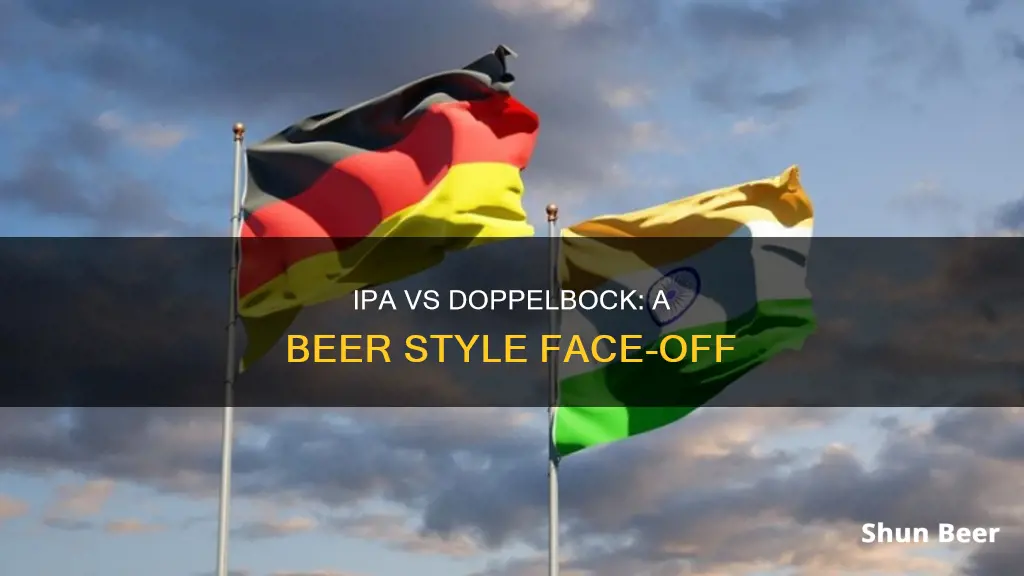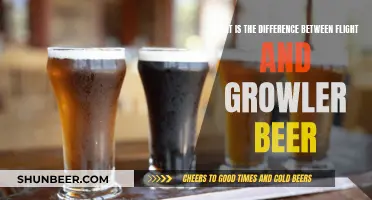
Doppelbock and IPA are two distinct styles of beer with unique characteristics. Doppelbock, meaning double bock in German, is a stronger and maltier version of the traditional German bock beer, with an alcoholic strength of 6.6-7.9% ABV or higher. It is known for its intense malt and caramel flavours, with a dominant malty sweetness and a full body. IPAs, or India Pale Ales, on the other hand, are known for their prominent hoppy characteristics, ranging from floral and fruity to bitter and pungent. They typically have a higher IBU (International Bitterness Units) range than Doppelbocks, resulting in a more bitter flavour profile. IPAs also tend to have a lower ABV, typically ranging from 5-7% but can go higher.
What You'll Learn

History of Doppelbock
Doppelbock, meaning "double bock", is a stronger version of the traditional bock style beer. It originated in the Bavaria region of Germany and was first brewed in the 17th century by monks at the Paulaner brewery in Munich.
The Paulaner monks were from the order of Saint Francis of Paola and practised periods of fasting, during which they allowed themselves no solid food. To help sustain themselves during these periods of reflection, they brewed a higher-gravity beer rich in nutrients, essentially "liquid bread". This beer was given the name Salvator, meaning "Holy Father", because of its sustaining qualities.
The monks were only supposed to brew for their own consumption, but they sold their beer to local citizens. In 1780, the monks were given permission to brew for commercial consumption, and the name doppelbock was given by local consumers. However, the commercialisation was short-lived. When Napoleon Bonaparte took control of the region, the monastery was closed and the brewery fell into the hands of the state.
The brewery remained closed until Franz Zacherl, owner of the Münchener Hellerbräu, rented the building and started brewing Salvator again. In 1813, he purchased the brewery and, after a legal battle, was finally given a full license in 1837 to brew and sell his beer.
Today, Doppelbock is still strong, ranging from 7% to 12% or more in alcohol volume. It is clear, with a colour ranging from dark gold to dark brown with ruby highlights. The aroma is intensely malty, with some toasty notes, and possibly some alcohol presence as well. The flavour is very rich and malty, with noticeable alcoholic strength and little or no detectable hops.
Cerveza vs Beer: What's the Difference?
You may want to see also

Doppelbock Characteristics
Doppelbocks are strong beers with a minimum original gravity of 18 degrees Plato and an ABV of 7% or higher. They are usually reddish-brown bottom-fermented lagers, with a toffee-like, bready aroma and a rich malty palate with notable residual sweetness. Doppelbocks are full-bodied and have a dominant malty sweetness that should not be cloying. The malt character is reminiscent of fresh and lightly toasted Munich-style malt, more so than caramel or toffee malt. Dark fruit flavours such as prune and raisin may also be present.
The colour of a Doppelbock can range from a rich gold to a dark ruddy brown. The head can vary between white and medium caramel colour, depending on the darkness of the beer, and it should retain well. Doppelbocks are malt-dominant beers, and the palate is summed up in rich maltiness with some contributing toasted and caramel aspects reminiscent of molasses. The stronger and darker the beer, the more pronounced the toasted character tends to be, though the roasted, burnt characteristics, like those found in stouts, should not be present. The finish is medium-full and very smooth, with some alcohol warmth.
Doppelbocks traditionally have a low bitterness and very little hop aroma and flavour. They are often paired with strong and savoury dishes like venison, cheeses such as brie or havarti, or as a complement to a rich dessert such as crème brûlée or tiramisu.
Dark Beer vs Stout: Unveiling the Mystery
You may want to see also

IPA Characteristics
IPA, or India Pale Ale, is a style of beer that originated in England in the 19th century. It is characterised by its strong, bitter flavour and high alcohol content. IPAs are typically pale in colour, ranging from light amber to deep gold, and have a prominent hop aroma and flavour. The hops used in IPAs can vary, but often include varieties such as Citra, Cascade, and Simcoe, which impart citrusy, piney, and fruity notes to the beer.
The flavour profile of an IPA can range from crisp and bitter to more balanced and malty, depending on the specific style and ingredients used. Some common flavours and aromas found in IPAs include citrus (such as orange, grapefruit, or lemon), pine, resin, tropical fruit (such as mango or papaya), and floral notes. The malt character in an IPA is typically less prominent than the hops, contributing a subtle sweetness and body to the beer.
IPAs often have a moderate to high alcohol content, ranging from 5% to 7% ABV or higher. They tend to have a medium to full body and a crisp, bitter finish. The mouthfeel of an IPA can vary depending on the style, but is generally smooth and well-carbonated.
There are several substyles of IPAs, including American IPA, English IPA, Double or Imperial IPA, and New England IPA. American IPAs tend to be more assertive and hop-forward, with a stronger bitterness and citrusy hop character. English IPAs are often more balanced, with a maltier profile and a less aggressive hop presence. Double or Imperial IPAs are stronger and more intense versions, with higher alcohol content and a more pronounced hop character. New England IPAs, also known as hazy IPAs, have a cloudy appearance and a smoother, less bitter flavour profile.
Overall, IPAs are characterised by their bold, bitter flavour, strong hop presence, and high alcohol content. They offer a wide range of flavour profiles and aromas, making them a popular choice for craft beer enthusiasts and those who enjoy complex and flavourful beers.
Gulping vs Sipping Beer: Does Drinking Style Affect Taste?
You may want to see also

Comparison of Doppelbock and IPA
Doppelbock and IPA are two distinct styles of beer with their own unique characteristics. Here is a detailed comparison of the two:
Doppelbock
The name Doppelbock translates to "double bock", indicating that it is a stronger version of the traditional German-style bock beer. This style of beer originated in Munich, Germany, and was first brewed by monks in the 17th century. Doppelbock is typically a dark lager, ranging in colour from copper to dark brown, with a thick, creamy head. It has a strong malt presence with intense flavours of caramel malt and a soft roast finish. The alcoholic strength of Doppelbock is on the higher end, typically ranging from 7% to 12% ABV or more. It is often described as a perfect winter beer due to its bold, dark, and sweet characteristics.
IPA
IPA, or India Pale Ale, is a style of beer that originated in England in the 19th century. It was originally brewed with higher hop rates and alcohol content to survive the long journey to India during the British colonial era. IPA has a strong hop presence, with a variety of flavour and aroma profiles depending on the type of hops used. Modern IPAs can be further categorized into substyles such as American IPA, English IPA, and Double IPA, each with its own unique characteristics. IPAs typically have a higher bitterness level and a more pronounced hop flavour compared to other beer styles.
Key Differences
The main difference between Doppelbock and IPA lies in their flavour profiles and origins. Doppelbock, with its strong malt presence and higher alcohol content, offers a bolder, sweeter taste, while IPA, known for its prominent hop character, provides a more bitter and aromatic experience. In terms of colour, Doppelbock tends to be darker, ranging from copper to dark brown, while IPAs can vary from golden to amber hues. Additionally, Doppelbock has a specific historical origin, tracing back to the monks of Munich, whereas IPA has a more diverse and widespread history, particularly associated with British colonial times.
Food Pairing
When it comes to food pairing, Doppelbock's rich and malty character pairs well with strong and savoury dishes like venison, cheeses such as Brie or Havarti, and even desserts like crème brûlée or tiramisu. On the other hand, IPA's bitterness and hoppy flavours complement spicy dishes, citrusy foods, and grilled meats or vegetables.
Exploring Beer, Whisky, and Rum: Unique Distinctions
You may want to see also

Recommended Food Pairings
India Pale Ale (IPA)
The key to pairing IPAs with food is to match the intensity of the beer with the intensity of the dish. IPAs are known for their bitterness, hop flavour, and caramel notes. When pairing with food, consider how you can complement these characteristics.
Hop flavours pair well with spices and light fruits. The bitterness of IPAs amplifies salty and umami flavours, and caramel notes in the beer complement sweeter dishes. IPAs also work well with fatty, fried foods as the carbonation helps to cut through the richness.
Some specific food pairings to try with IPAs include:
- Spicy dishes such as Indian or Thai cuisine
- Salty and fried foods like chicken wings or cheese curds
- Grilled meats such as burgers or steaks
- Mexican food like fajitas or fish tacos
- Desserts with chocolate or caramel, such as carrot cake
Doppelbock
Doppelbocks are full-bodied beers with a dominant malty sweetness and notes of toasted bread. They are very food-friendly and pair well with a variety of dishes.
Doppelbocks pair particularly well with gamey meats such as venison, boar, duck, and goose, especially when served with a tangy or fruity sauce. They also complement pork, potatoes, and the earthy flavours of Mexican dishes. For dessert, doppelbocks can be paired with custard or chocolate.
Some other food pairings to try with Doppelbock include:
- Aged cheese and prosciutto
- Mushroom dishes, such as porcini mushroom linguine
- Creamy pasta dishes
- Bread, cheese, and tomato-based sauces
Exploring the Diverse World of Michelob Beers
You may want to see also
Frequently asked questions
India Pale Ale gets its name and unique style from British brewers who were making beer for export to India. This style has an intense hop flavour which was used to preserve the beer for the long voyage.
Doppelbock is a strong, bold, dark beer with a sweet and salty balance. It is a bigger and stronger version of the lower-gravity German-style bock beers. Doppelbock is extremely versatile and can be paired with many different types of food.
The main difference between an IPA and a Doppelbock is the flavour profile. IPAs have an intense hop flavour, while Doppelbocks have bold, malty flavours with notes of dark fruit, caramel, and chocolate.







